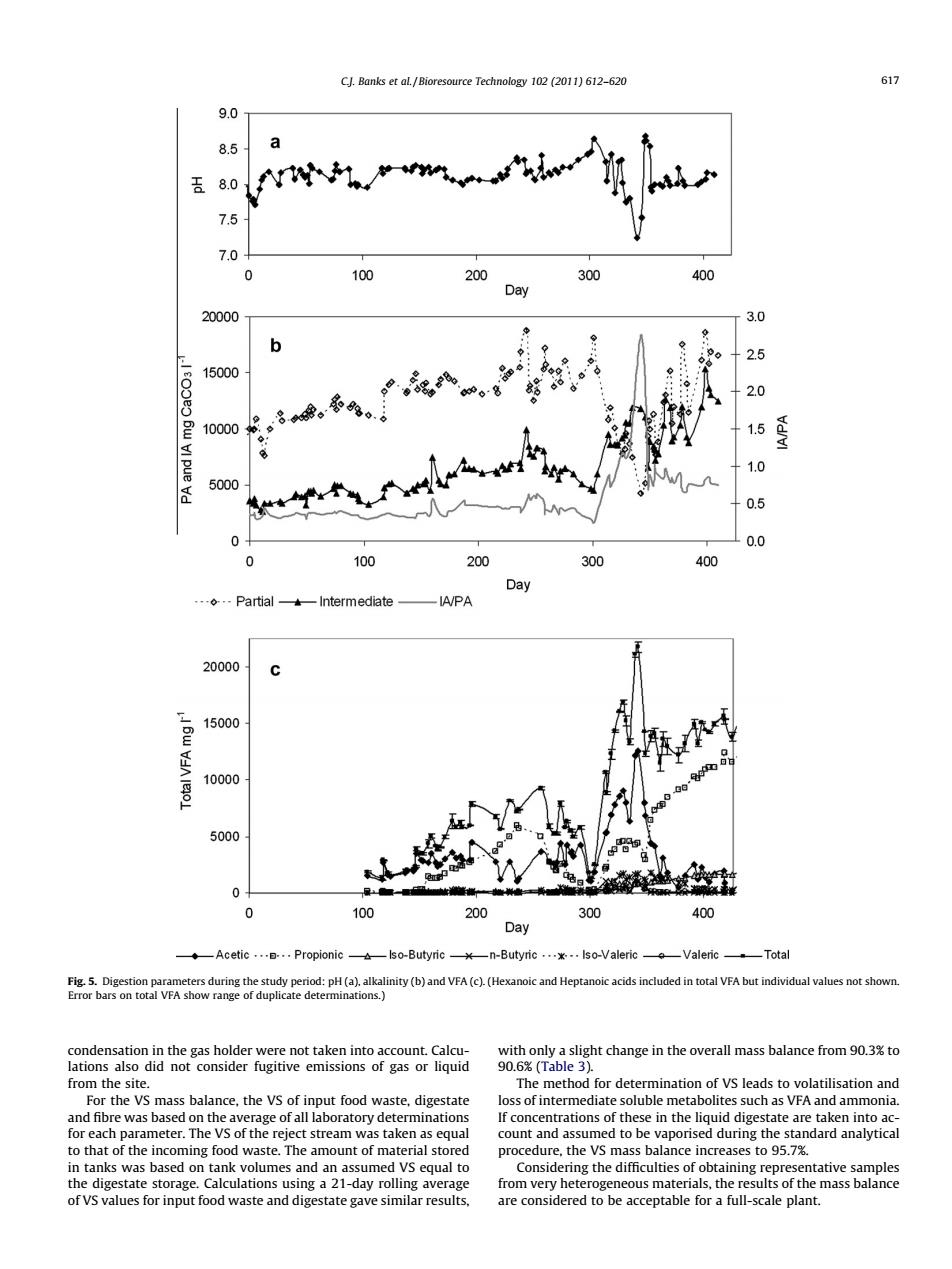正在加载图片...

CJ.Banks et al./Bioresource Technology 102(2011)612-620 617 9.0 8.5 a 舌 8.0 7.5 7.0- 0 100 200 300 400 Day 20000 3.0 b 2.5 15000 2.0 是 10000 1.5 pue vd 1.0 5000 0.5 0.0 0 100 200 300 400 Day ---0--PartialIntermediate- -IA/PA 20000 Q 15000 是 10000 5000 0 0 100 200 300 400 Day ◆-Acetic……Propionic lso-Butyric -n-Butyric…w…lso-Valeric -Valeric Total Fig.5.Digestion parameters during the study period:pH(a).alkalinity(b)and VFA(c).(Hexanoic and Heptanoic acids included in total VFA but individual values not shown. Error bars on total VFA show range of duplicate determinations.) condensation in the gas holder were not taken into account.Calcu- with only a slight change in the overall mass balance from 90.3%to lations also did not consider fugitive emissions of gas or liquid 90.6%(Table3). from the site. The method for determination of VS leads to volatilisation and For the VS mass balance,the VS of input food waste,digestate loss of intermediate soluble metabolites such as VFA and ammonia. and fibre was based on the average of all laboratory determinations If concentrations of these in the liquid digestate are taken into ac- for each parameter.The VS of the reject stream was taken as equal count and assumed to be vaporised during the standard analytical to that of the incoming food waste.The amount of material stored procedure,the VS mass balance increases to 95.7%. in tanks was based on tank volumes and an assumed VS equal to Considering the difficulties of obtaining representative samples the digestate storage.Calculations using a 21-day rolling average from very heterogeneous materials,the results of the mass balance of VS values for input food waste and digestate gave similar results, are considered to be acceptable for a full-scale plant.condensation in the gas holder were not taken into account. Calculations also did not consider fugitive emissions of gas or liquid from the site. For the VS mass balance, the VS of input food waste, digestate and fibre was based on the average of all laboratory determinations for each parameter. The VS of the reject stream was taken as equal to that of the incoming food waste. The amount of material stored in tanks was based on tank volumes and an assumed VS equal to the digestate storage. Calculations using a 21-day rolling average of VS values for input food waste and digestate gave similar results, with only a slight change in the overall mass balance from 90.3% to 90.6% (Table 3). The method for determination of VS leads to volatilisation and loss of intermediate soluble metabolites such as VFA and ammonia. If concentrations of these in the liquid digestate are taken into account and assumed to be vaporised during the standard analytical procedure, the VS mass balance increases to 95.7%. Considering the difficulties of obtaining representative samples from very heterogeneous materials, the results of the mass balance are considered to be acceptable for a full-scale plant. Fig. 5. Digestion parameters during the study period: pH (a), alkalinity (b) and VFA (c). (Hexanoic and Heptanoic acids included in total VFA but individual values not shown. Error bars on total VFA show range of duplicate determinations.) C.J. Banks et al. / Bioresource Technology 102 (2011) 612–620 617